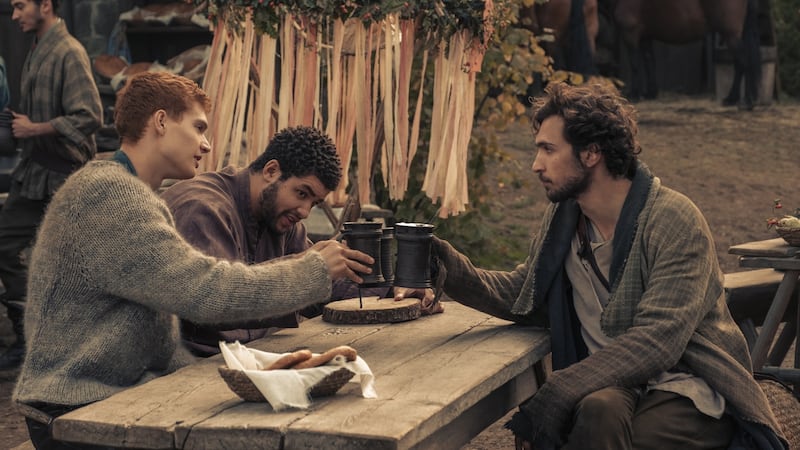There’s a surprise for Irish viewers a few episodes into Amazon’s exhilarating new fantasy series The Wheel of Time, when Maria Doyle Kennedy turns up at the head of a vividly hued wagon train. She plays Ila, a leader of the “Tuatha’an”.
The Tuatha’an, according to the semi-official Wheel of Time wiki, are “a nomadic people who live in brightly painted wagons”. They are also known, the wiki continues, as the Travelling People.
Just so the Irish reference didn't escape you, Ila's sidekick, Aram, is played by another homegrown actor, Daryl McCormack (Vikings, Peaky Blinders, Fair City). All but greeting us with "Howya, bud?", he sounds like he's bound for Tallaght rather than Tar Valon. And he brings a cheery Dublin irreverence to this realm of wizards, warriors and glinting CGI citadels, which is now airing on Amazon Prime Video.
The Wheel of Time is a hotchpotch of cultures and historical eras
The Wheel of Time is adapted from the sprawling fantasy saga by Robert Jordan. And Jordan quite obviously adapted the Tuatha’an from the Tuatha Dé Danann, the supernatural demigods of Irish mythology.
Among readers of the books it is widely assumed the Travelling People are modelled on Irish Travellers. Which is presumably why Doyle Kennedy and McCormack were allowed to speak in their native accents when everyone else in The Wheel of Time affects a cod-British Shakespearean timbre (no matter that several of the cast are from Australia and New Zealand).
Jordan, a former dance and theatre critic who served two tours of duty as a helicopter gunner in Vietnam, was clearly partial to Irish mythology. His grand tale begins with the humble townsfolk of the village of Emond’s Field preparing to celebrate Bel Tine, a spring festival whose name is almost certainly a corruption of Bealtaine, the old Irish May Day.

His poking around in Irish folklore will have also introduced him to the concept of the aes sídhe, or aos sí, another magic-wielding race from ancient Ireland. Or so we must conclude given the name Jordan chose for his sect of warrior priestesses dedicated to policing the use of magic: the Aes Sedai (pronounced “Eye Said Eye”).
Ireland wasn’t singled out for special treatment by Jordan, it should be acknowledged. Though set in the far future, The Wheel of Time is a hotchpotch of cultures and historical eras – further into the novels there are analogues of imperial Japan, Ming-dynasty China, medieval Spain, the Teutonic Knights and more.
Jordan was unusually explicit about drawing on stereotypes about the Irish. He explained, for instance, that he had gone out of his way to give the Aiel, his desert-warrior race, the “classic” Irish features of red hair and pale eyes. This to subvert the idea that people who live in hot climates tend to look a certain way. The Aiel inhabit the vast arid hellscape of the Aiel Waste, to the east of the Spine of the World mountain range. Jordan wanted them to appear as if they’d just arrived from north Cork.
All the way back to The Lord of the Rings, the genre has taken liberally from Irish folklore
The Wheel of Time is one of the most widely cherished of all fantasy sagas. In terms of sales it is neck and neck with George RR Martin’s A Song of Ice and Fire, with about 90 million copies shifted. And the new Amazon series, with an appropriately epic $100 million budget, captures the scope and the intrigue of the books. Yet in chucking in a random assortment of Irish references, Jordan was leaning into a long-running fantasy cliche.
All the way back to The Lord of the Rings, the genre has taken liberally from Irish folklore. Tolkien denied any debt to Celtic mythology – which he in fact went to lengths to disdain. He once observed that Celtic legends “have bright colour, but are like a broken stained-glass window reassembled without design”.
Perhaps he protested too much. It is today widely agreed the Burren was at least partly an inspiration for the blasted desolation of Mordor. (Tolkien was a frequent visitor to Co Clare as external examiner for what was then University College Galway). It is believed, too, that the Noldor, his ancient elf race, owed something to the Tuatha Dé Danann. The similarities between the old Celtic villain Balor of the Evil Eye and Sauron, the Great Unblinking Eye of Barad-dûr, do not, meanwhile, require elaboration.
If The Wheel of Time contains much that it is familiar, its world-building also finds a way to weave in that which is new and surprising
Fantasy has always cribbed with abandon from real cultures, and there is no reason Ireland should be an exception. Occasionally the ransacking lacks subtlety, however. In Andrzej Sapkowski’s Witcher novels, for instance, forest-dwelling dryads greet each other by shouting “Ceadmil eithne!” This is not magpie syndrome run amok. It is cod Irish gleaned from a random internet search in a manner that implies the language is not a living thing but a repository for fantasy authors requiring weird syllables to lump together. (Welsh suffers much the same treatment.)
The good news is that The Wheel of Time tries to subvert rather than lean into stereotypes. The Tuatha’an appear to be a shorthand for “the Irish” in this world. Yet Jordan rejected the trope of the fighting Irish. Rather than wading into challenges with raised fists, the Traveling People follow a code called “the Way of the Leaf”, which forbids violence.
So while representing Jordan’s wink towards the old sod, they’re also fantastical hippies, spreading peace, love and understanding. It is a reminder that, if The Wheel of Time contains much that it is familiar, its world-building also finds a way to weave in that which is new and surprising.
The Wheel of Time is available on Amazon Prime Video













